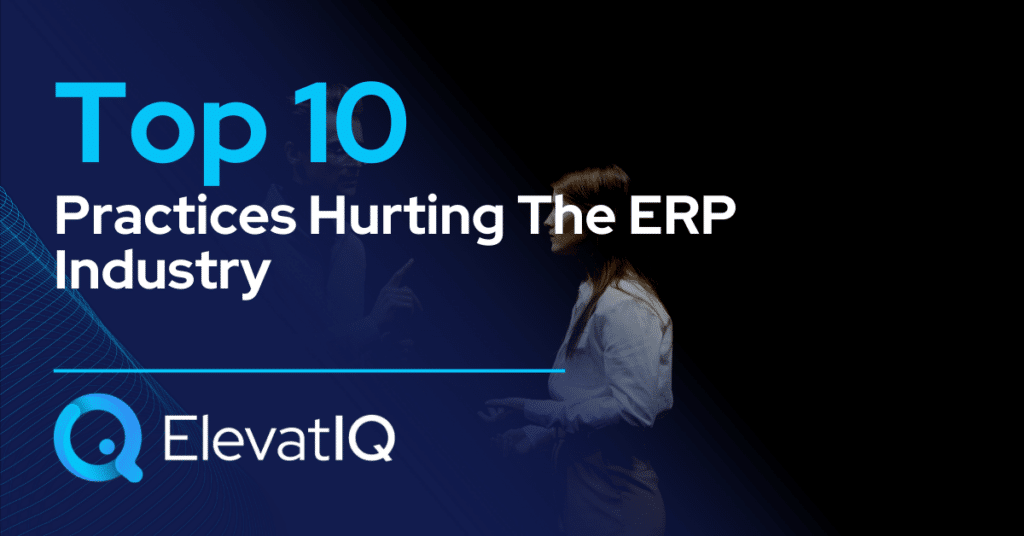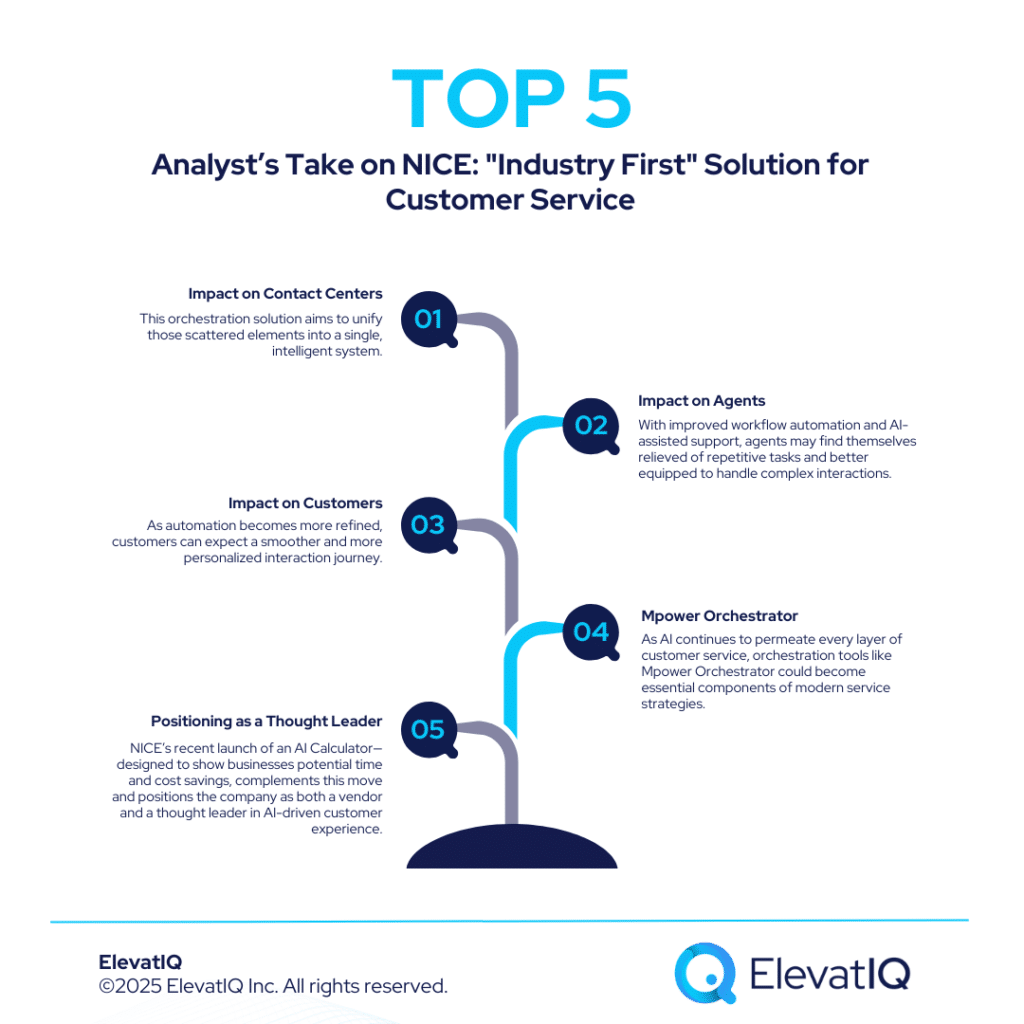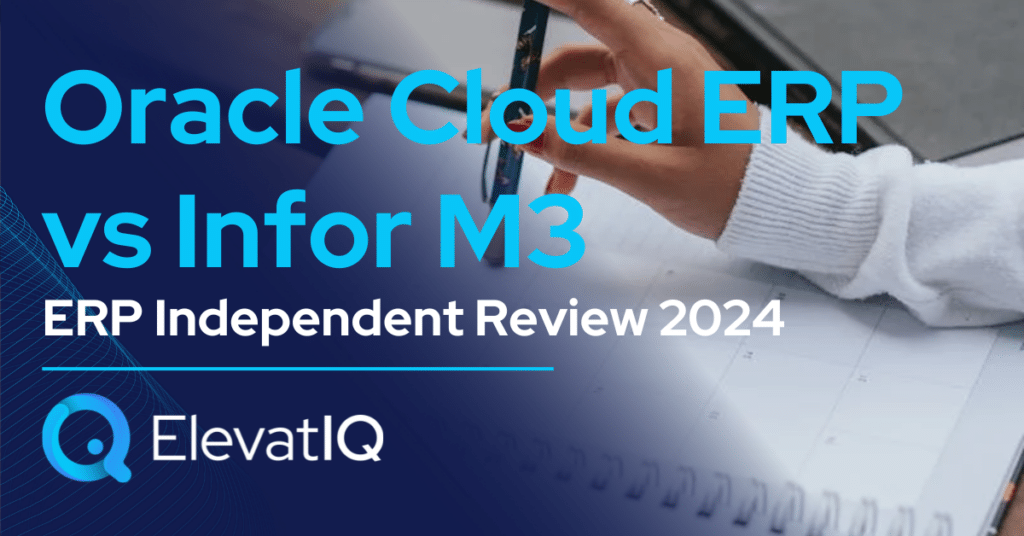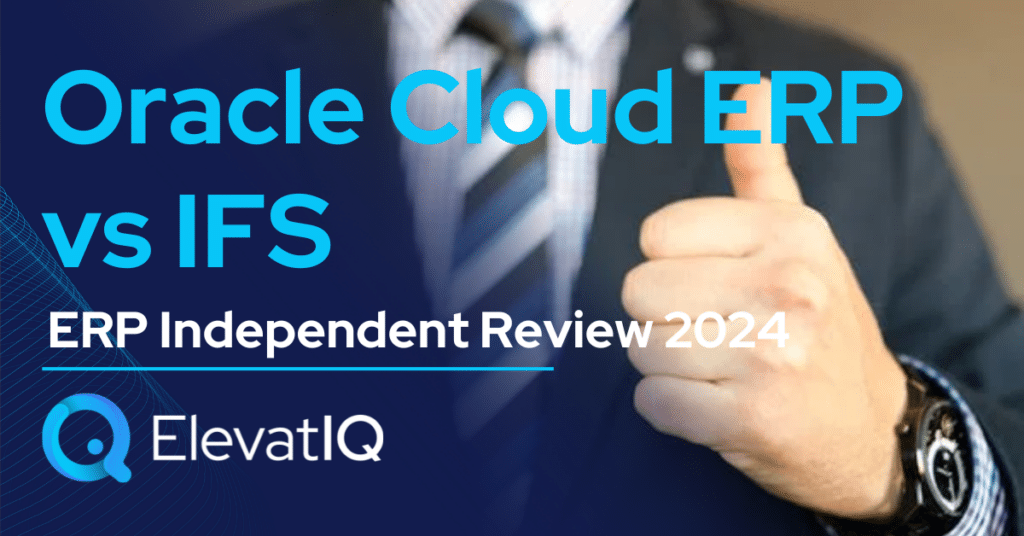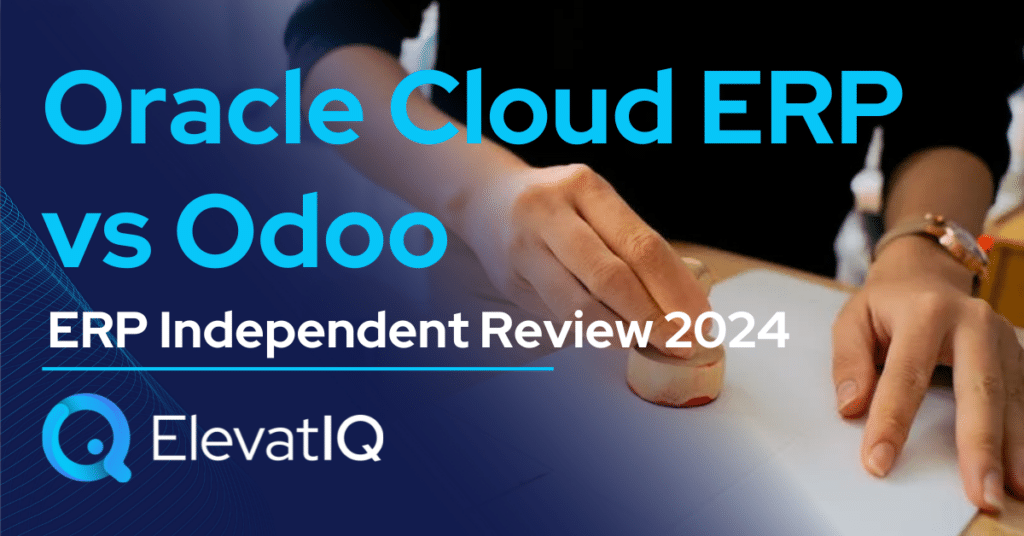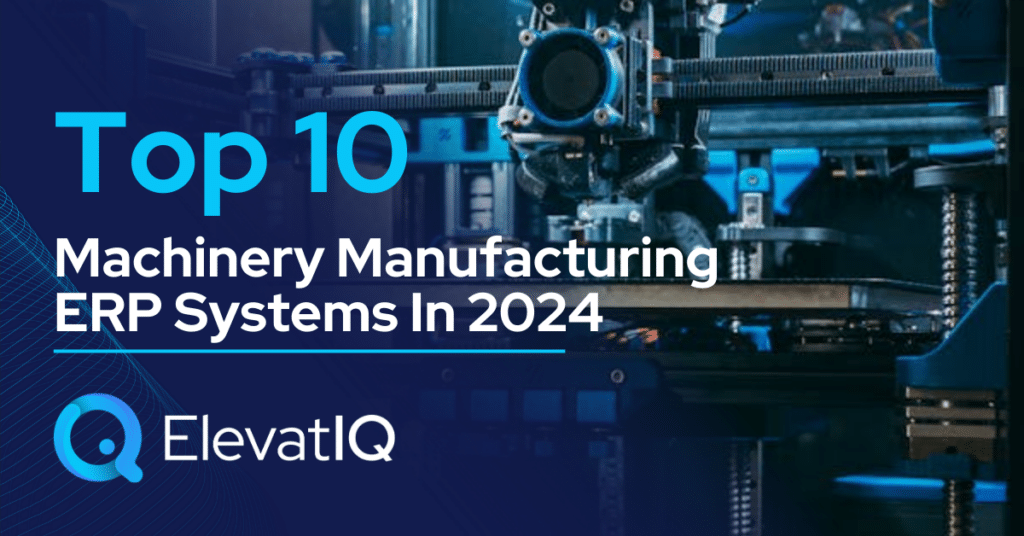Last Updated on March 17, 2025 by Sam Gupta
The enterprise software (or ERP) industry has always struggled to justify its hefty price tags. Seriously, why is software still breaking the bank when the hardware is on a discount spree? Remember the good ol’ days of on-prem software? Customers were just getting used to paying for support and licenses. But then the cloud came in like a storm, demanding they shell out nearly ten times more! Talk about a shocker. It’s enough to give enterprise software reps nightmares. Result? They had to downplay the importance of design, architecture, implementation, and change management to close deals. And that’s when things took a wild turn in this industry.
Welcome to the era of marketing genius! But let’s be real. These practices might be dragging the ERP industry down, despite the tech advancements. The race to come up with buzzwords and peddle misleading conclusions like “easy-peasy software implementation” has become a sport. It’s almost a joke to ERP implementation consultants when reps claim that anyone with a laptop might be able to integrate cloud ERP software. Who needs enterprise architecture in the cloud? The never-ending race, right?

Buzzwords, buzzwords, and more buzzwords! They promise the moon and stars, faster value, and lightning-fast implementation. But guess what? It’s all a bunch of baloney! Those buzzwords are more deceptive than a politician’s speech. And you know what happens next? Customers end up making silly decisions like rushing to go live or skipping user training. And the result? Their confidence in digital transformation takes a nosedive. And who’s to blame? These practices, my friend.
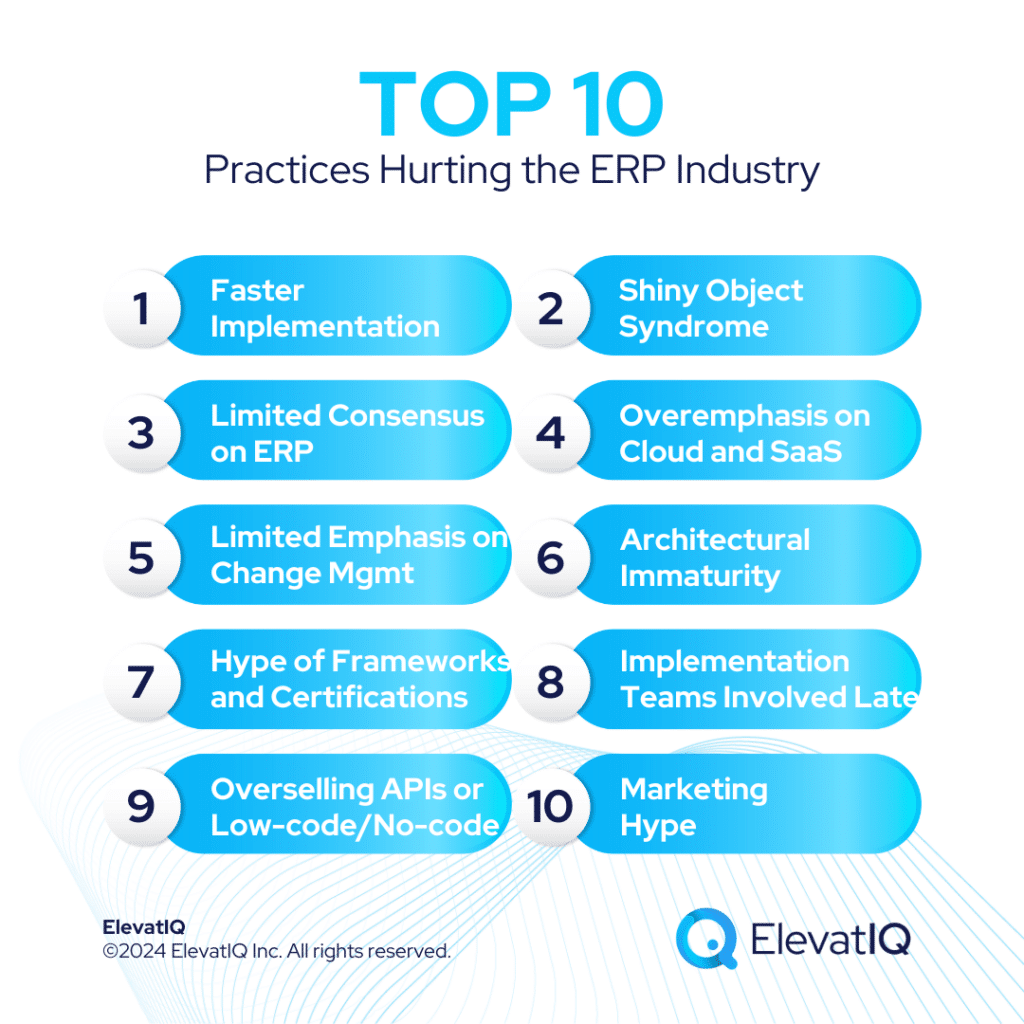
10. Marketing Hype
Marketing hype like the Bill of Rights is meant to show how much ERP vendors care, but let’s be real; it’s mostly fluff. In fact, it can backfire if you don’t evaluate it carefully.
- Functional checklists. Provided by OEMs and resellers to help customers manage the ERP selection process in the DIY mode. But they’re often biased (written from their perspective) and leave people confused. They make all solutions seem similar and distract from what really matters (leaving people to focus on other “touchy-feely” issues). Technical issues get downplayed, too.
- Consumption-based business model. Pitched as a generous favor from vendors, but it’s not always better. Both named and consumption-based models could be equally good depending on the context. The consumption-based model comes with a performance tier, which is often overlooked while unlimited users take the spotlight.
- Bill of Rights. Some OEMs promote their Bill of Rights as if they’re the only fair players, but most of it lacks tangible value. It’s just a marketing gimmick, so don’t fall for it. Access to data sounds good, but it’s useless without their software.
- Fake cloud. Don’t be fooled by those offerings claiming to be cloud-based; they lack essential cloud perks. They’re just slapping on the word “cloud” to give you that “cloudy” feeling. It’s like putting lipstick on a pig – it’s still a pig.
Don’t buy into marketing hype. It’s all about putting down the competition or slyly nudging you in their direction, even if they dress it up with a smile. Whether it’s negative marketing or shiny hype, they’re just playing the same game.
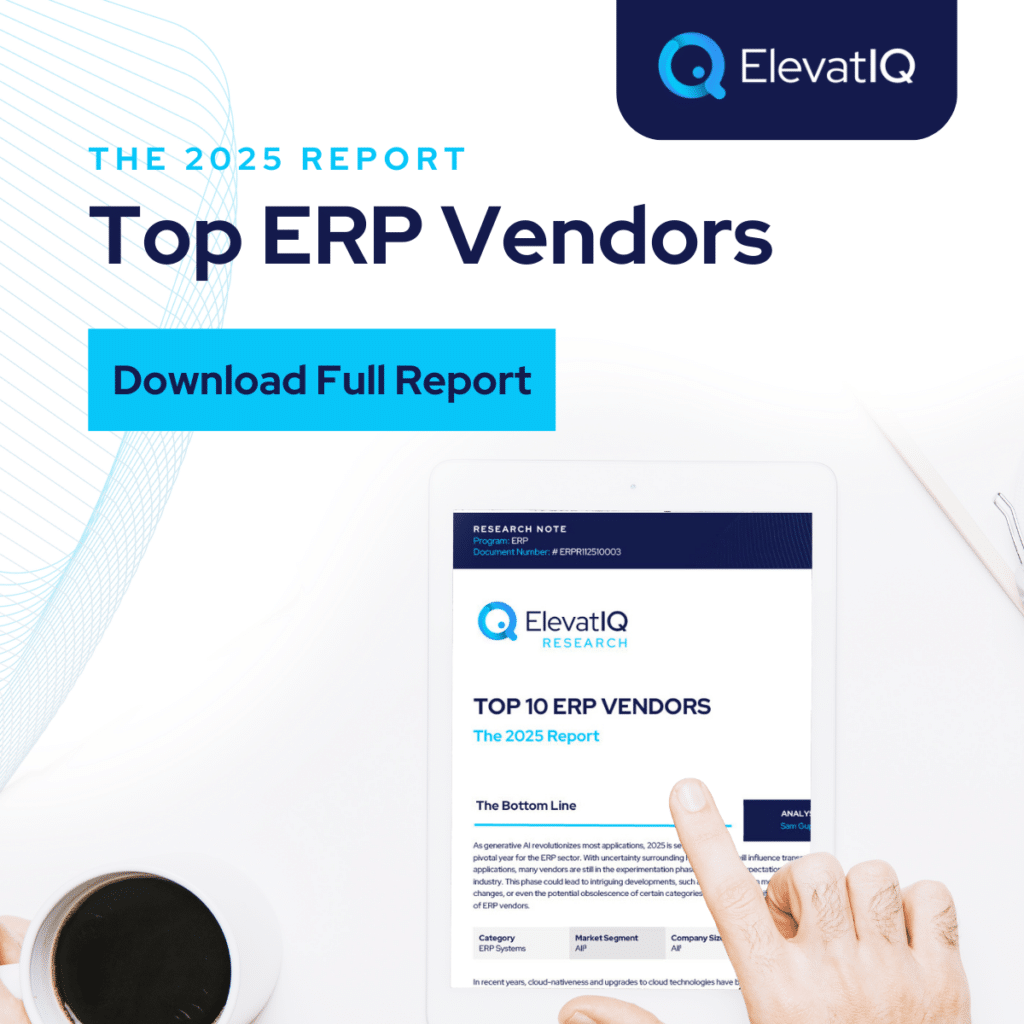
9. Perception of APIs or Low-code/No-code
Traditionally, there’s always been a misalignment in expectations between business users and technical teams. Business users think tech wizards can work magic with vague instructions, while techies want clear specs before diving in. This gave birth to low-code/no-code tools, where business users could try their hand at coding. Sadly, though, low-code/no-code only adds to the mess of brittle code and lousy architecture.
- Overselling of low-code and no-code and APIs. Instead of hyping up no-code and low-code, the ERP industry should emphasize the value of writing solid requirements without ambiguity.
- Overselling of giving control to citizen devs. Citizen devs, listen up! It’s time to channel your inner tech guru. Instead of trying to do it all, focus on providing clear inputs.
- Over-emphasizing the importance of code. Let’s face it. Writing code is like following a recipe for mac and cheese—pretty straightforward. The real challenge lies in whipping up a delicious design and nailing those specs. So instead of obsessing over mastering new programming languages, prioritize writing requirements that can pass the “SMART” test. That way, you’ll be cooking up success in no time!
- Undermining the importance of good requirements, design, and test cases. When it comes to software, requirements, design, and test cases are like a dynamic trio. They’re BFFs, inseparable! Their quality determines how tasty your implementation will be and how smoothly your processes will run.
The obsession with low-code and no-code is dragging the industry back and causing architectural messes. It’s time to shift gears and prioritize coaching business users on creating solid specs and designs.

8. Delayed Involvement of Implementation Teams
Enterprise software vendors often sideline their implementation teams during the sales process, fearing they’ll reveal too much information and jeopardize their competitive edge in the deal. Sadly, it’s the ERP implementation teams left to deal with the fallout of unrealistic commitments made by the ERP sales reps, limiting their capabilities despite their competence.
- Implementation teams are only involved after the damage is already done. When dealing with ERP vendors, insist on involving the person accountable for implementation and have their name on the contract.
- Major architectural decisions are already made by decision-makers with very little hands-on implementation experience. Success in ERP implementation comes from balancing business and technical perspectives. It’s not a one-and-done affair where you throw the “WHAT” at your technical teams and expect them to magically conjure the “HOW.” The process is iterative, involving decision-making and feasibility analysis. So, hold off on decisions until you have someone with solid implementation experience to guide you through the pros and cons, both financially and technically.
- The gap between the implementation and the sales teams. Flipping through marketing brochures to answer sales objections is not the same as implementing. It requires much deeper probing of design and architectural issues that ERP sales reps don’t have exposure to.
- The selection teams with very little implementation expertise. Avoid ERP selection consultants who rely solely on tech vendors for architectural and technical decisions—look for hands-on implementation expertise instead.
Regardless of the reasons, political or genuine, keeping implementation teams out during the ERP selection and design phase harms the ERP industry. And yes, technical teams might be perceived as too detailed oriented, but lacking implementation experience in the pre-implementation phase is equally risky.
7. Overselling of Frameworks and Technical Certifications
The enterprise software and ERP industry is brimming with frameworks and certifications, each claiming its own formula for success. But here’s the catch: these frameworks often assume constraints that don’t align with clients’ unique environments. To achieve true operational efficiency in ERP implementations, judgment is more important than frameworks.

- Frameworks and certifications are used as a shield for implementation success. Certifications and frameworks don’t guarantee implementation success. It’s not about parroting concepts but how you apply them that counts in ERP implementations. So, don’t judge a book by its certification!
- ERP project is successful but limited tangible business results. Can you Imagine working harder after a “successful” ERP implementation? Siloed approaches promoted by frameworks and certifications without a business-focused analysis can still leave you swimming in inefficiencies, despite all the investments.
- Technical certifications designed with the product boilerplate. Certifications often drown in product jargon that may not even apply. They can lead you so deep into the product rabbit hole that you lose sight of the real world.
- Certifications are too biased toward the product than toward the customers’ success. Product certifications tend to get too wrapped up in the product concept. While they may offer best practices from their perspective, every installation has its unique context. It’s like trying to fit a square peg in a round hole of possibilities!
Avoid vendors that oversell the importance of certifications. The certifications and frameworks go only so far. The industry needs to water down the importance of certifications and frameworks and design them that test consultants’ judgment on customer success and industry knowledge.
6. Architectural Immaturity
ERP vendors selling cloud often downplay the importance of architecture. And remember, architecture isn’t just about technology—it’s about getting all Fs equally represented: form, fit, function, finance, fanbase, and future-proofing.
- APIs are used as a shield for architecture. APIs have successfully masked the proprietary boilerplate of underlying technologies, providing a secure and unified way to access information, just like a user interface (UI). However, some ERP sales reps, lacking implementation and technical prowess, tend to exaggerate the capabilities of APIs, mistakenly believing they can replace the need for solid architecture and workflow design.
- Significant communication issues with systems. ERP implementations that postpone integration and communication workflows to the implementation phase can stumble upon reconciliation challenges.
- System adoption issues. Poor architectural choices can turn your user experience into a bumpy ride, tempting them to hijack processes and create parallel siloed systems. And guess what? That leads to some serious adoption issues.
- Involve technical teams with architectural experience during ERP selection. When technical and implementation teams join forces during solution design, magic happens! It’s like assembling the Avengers of the enterprise world!
- Misunderstanding of data stores and reconciliation workflows in the architecture. User experience and operational overhead are like two rival forces locked in an eternal struggle. The more data siloes, the more reconciliation efforts and operational overhead you’ll face.
As we leap ahead with technological advancements, our architectural maturity seems to lag behind. While technology can streamline workflows and processes, it’s no magic wand that conjures up flawless architecture with a simple flick.
5. Lack of Emphasis on Change Management
While most regard change management as a critical component for successful digital transformation initiatives, the boundaries often get blurred. The truth is, effective change management requires aligning perspectives, documenting to mitigate risks, and treating it like a central function, just like a general contractor who takes responsibility for the entire project.
- Change management is not meaningful without ERP subject matter expertise. Change management without ERP expertise is like trying to drive a car without knowing how to steer. To effectively manage and align everyone’s expectations, you need change management consultants who have ERP subject matter expertise and understand different technologies to be able to communicate effectively with all teams involved. Don’t settle for a change management team that’s all talk and limited ERP know-how.
- Too much emphasis on users who might not understand the implications of architectural experience. Putting untrained and unqualified users in charge of critical business processes and architectural decisions is like handing the car keys to a toddler. Sure, their opinions matter, but expecting them to make informed choices without proper information and guidance? It’s a recipe for disaster. Empower your users with the right knowledge and support, so they can contribute meaningfully to the decision-making process. Remember, architecture and business process decisions are best left to the experts. The right experts excel at facilitating decisions without applying pressure. They guide, not impose.
Change management is the secret sauce that keeps the system sizzling. Ignoring its importance is like going in circles without making progress. If the ERP industry gave change management the spotlight and the right ingredients, customers would feast on business results, fueling industry growth.
4. Overemphasis on Cloud and SaaS Technologies
The ERP industry loves to hype up SaaS and cloud technologies as plug-and-play fixes. They mistakenly believe that a bunch of SaaS solutions patched up together automatically equals tightly integrated processes and financial control achieved through ERP-like architecture.
- Cloud is a solution to all problems. Cloud is not meant to be a solution to all problems. Purchasing SaaS won’t automatically solve your business and performance issues.
- Too much licensing fee, very little results. Yes, SaaS is more expensive than on-prem as vendors need to follow the guidelines related to cybersecurity and data loss, which are often ignored when managed internally. But unfortunately, paying more for SaaS is not a replacement for good design. ERP vendors need to justify their costs, and they do so by downplaying the importance of change management, the cost of implementation, and the efforts involved with good solution architecture. Listening to them is like taking advice from your competitors.
- New problem? Throw a new SaaS. Lacking proper architecture and solution design can result in a never-ending loop of purchasing SaaS without experiencing any real business improvements or, worse, undoing the benefits you’ve already gained.
- Architecture, business systems, and master data governance teams were not involved before buying SaaS. The ERP industry often misguides companies by suggesting that SaaS purchase decisions can be made at the department level, without considering the enterprise architecture, master data governance, and impact on other departments. This approach only results in duplicated efforts, more data siloes, and a loss of overall enterprise value.
A tool is just a tool, no matter how powerful it claims to be. So don’t expect a pricey tool to magically generate money or enterprise value for you. Life isn’t as simple as SaaS sales reps make it sound.
3. No Consensus on the Definition of ERP
The ERP industry struggles with defining ERP due to differing industry expectations. They simplified the term ERP for business users to grasp, but this misunderstanding leads to misguided decisions, ultimately leading to lost confidence in digital transformation initiatives.
- Every business has a new definition of ERP. Sadly, without considering business processes, reconciliation workflows, and operational overhead, grasping the true value of ERP is like chasing a ghost. The ERP industry should move beyond the term “ERP” and focus on the importance of ERP-like architecture, the key ingredient for operational growth and unlocking enterprise value.
- Misunderstanding of the importance of ERP. Unfortunately, unless you have hands-on experience in growing businesses with an ERP-like system, grasping the true essence of a real ERP is as elusive as a unicorn. Also, the added noise with systems claiming to be ERPs just because they tick a few boxes does not help either.
- The role of add-ons and auxiliary systems. Most ERPs started as siloed apps, but then they had to become tightly integrated as that’s what businesses needed to scale. The role of add-ons is generally misunderstood. Whether add-ons are third-party or included as part of the solution, they are just another data silo if you think from the perspective of architecture.
The ERP industry is the master of confusion, cashing in on ERP misunderstandings and preconceived notions. But what we truly need is a clear message about the significance of ERP-centric architecture and operational process design.
2. Shiny Object Syndrome
The ERP industry loves to come up with shiny objects, and let’s admit it, we all have a weakness for them. But chasing after shiny objects often leaves companies disappointed with technology initiatives, as well as missing out on the opportunity to seek the right help that could truly transform their businesses.

- New technology must solve all business problems. Don’t be blinded by the glimmer of shiny new tech. Before diving in, ask: Will it truly add value? Take a deep dive into operational data and workflow assessments, perform root cause analysis through process models, and vet potential solutions diligently before procuring and implementing them. But remember, if broken processes and data are the core issue, a fancy tech will only make the mess grow at a faster speed.
- Rat race towards technology. Ever heard the team chant, “Must we follow the tech trend or will we be left behind?” Or worse, do you find yourself beating that drum? Well, here’s the truth: Technology alone won’t boost your business prowess. It’s all about how you use it that makes a difference.
- Technology-centric ERP system selection decisions. Transforming initiatives shouldn’t be fueled solely by the need to modernize IT. Focus needs to be on the business’s beating heart instead.
Hey ERP industry, stop caching on customers’ shiny object obsession! And companies, wake up! Chasing shiny objects will only lead to digital transformation doubt and put the brakes on ERP industry growth.
1. Faster Implementation Times
ERP publishers engage in a rat race for implementation speed to secure contracts and ensure renewals, sacrificing adoption risks in the process. Ironically, analyst firms inaccurately rely on implementation time as a metric, failing to consider the true measure of technological advancements and efficiency gains. This needs to stop!
- The misunderstanding of the term “implementation.” The problem with faster implementation is that it’s not just about system setup. While some systems are user-friendly, human learning and consensus-building take up the majority of the time in ERP projects. The problem with faster implementation is that it assumes data and processes are ready to go, with all specifications fully vetted. It also assumes you’re a pro at making decisions on countless variables for operational efficiencies.
- Rat race of faster implementation times. The rat race began because software vendors had to meet quarterly targets. While technology has sped up the process, expecting to go live within 90 days is trouble waiting to happen. Also, comparing implementation times is like comparing apples to oranges. Just because your peers did it in two weeks doesn’t mean you can too. What if they spent years perfecting their processes before signing the contract?
Asking for a faster implementation is like asking for a one-way ticket to hell. Don’t expect a happy ending when going live on an unstable system with untrained users. Time to wake up and ignore those ERP vendors pushing for speed just to boost their stats. Hell isn’t the dream getaway for your ERP project, trust me!
Final Words
Enterprise software will never catch up with the hardware’s discount extravaganza. It’ll always burn a bigger hole in your pocket because of the nature of the beast.
It’s high time for ERP software vendors to learn how to prove their worth instead of endorsing practices that’ll ultimately harm the industry. Wise folks say there are no shortcuts in life, and faking it will only take you so far! Now, the big question is, will the ERP industry let go of its cloudy judgment for the greater good of the ERP community?


